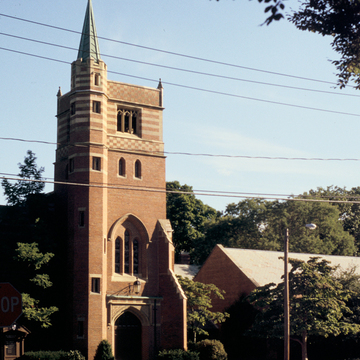Although justifiably attributed to Frank Patterson Smith, the design of Winchester's Episcopal Church of the Epiphany also represents the ideas of Smith's senior partner, H. Langford Warren. Warren established the architecture program at Harvard University, ultimately becoming dean, and was a longtime president of the Society of Arts and Crafts, Boston. A member of the Epiphany parish, Smith provided a sustained vision to a project built over many decades. The design evokes the English parish church, a favorite model for suburban churches. Inside, the trussed roof and masonry-vaulted aisles reveal Warren's academic interest in reviving medieval construction. Handcrafted materials, promoted by the Society of Arts and Crafts,
You are here
Church of the Epiphany
1904–1905, Warren, Smith and Biscoe; 1910–1911 parish hall and cloister, Warren and Smith; 1925–1926 parish house addition, Frank Patterson Smith; 1940 tower, Frank Patterson Smith; 1959 Hadley Hall, Perry, Shaw, Hepburn and Dean. 70 Church St.
If SAH Archipedia has been useful to you, please consider supporting it.
SAH Archipedia tells the story of the United States through its buildings, landscapes, and cities. This freely available resource empowers the public with authoritative knowledge that deepens their understanding and appreciation of the built environment. But the Society of Architectural Historians, which created SAH Archipedia with University of Virginia Press, needs your support to maintain the high-caliber research, writing, photography, cartography, editing, design, and programming that make SAH Archipedia a trusted online resource available to all who value the history of place, heritage tourism, and learning.















